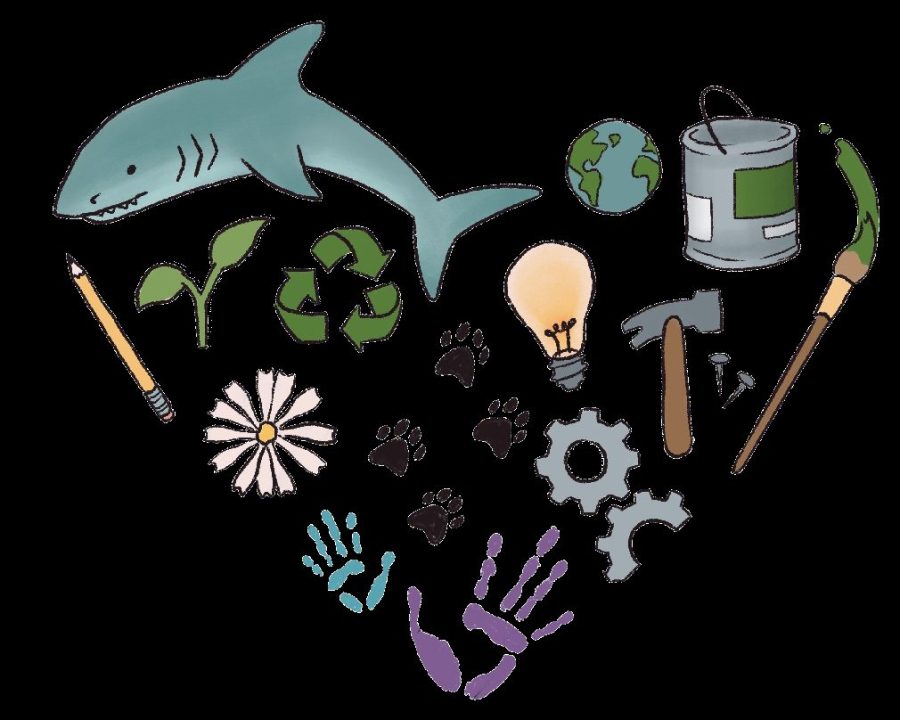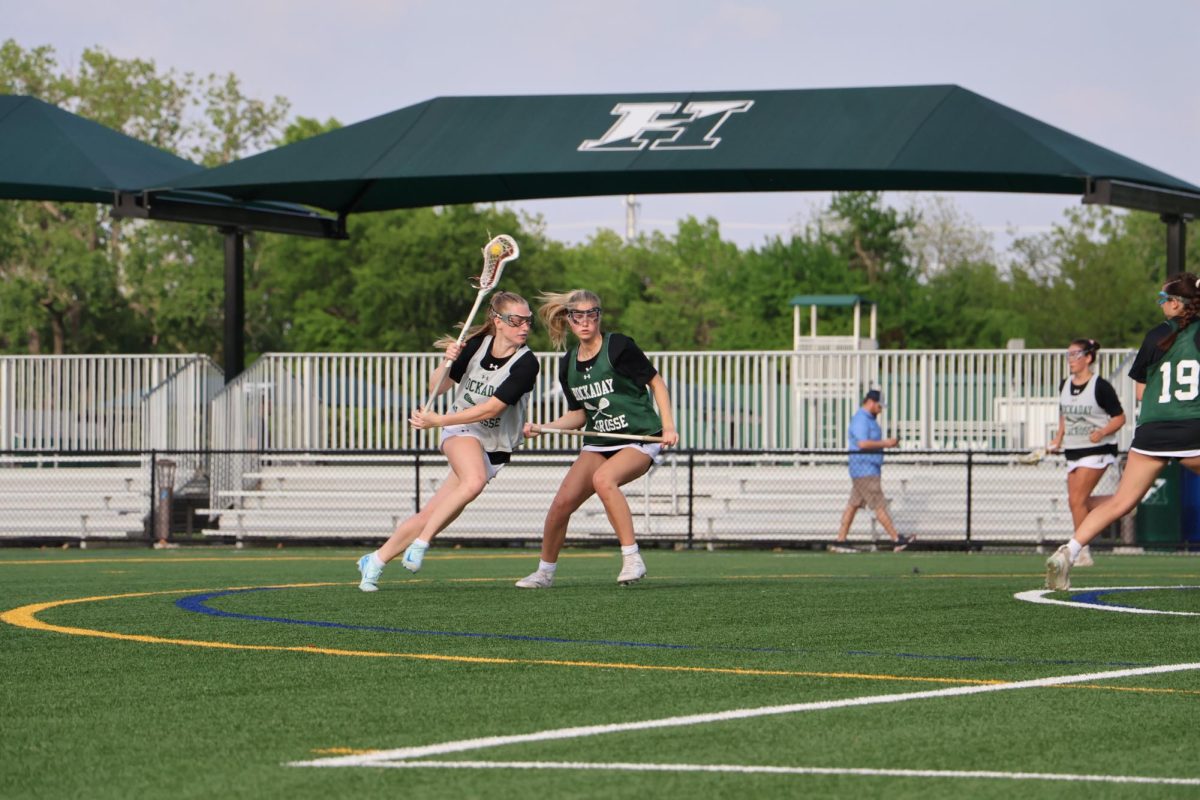Emphasizing Empathy
Hockaday integrates social impact into curriculums as early as preschool. Each grade learns about different social issues such as hunger, homelessness and community engagement.
September 30, 2022
Partnering with the Dallas Zoo, pitching Shark Tank business presentations, dressing like Disney characters and analyzing first graders reading to dogs don’t sound like typical class projects. That’s because they aren’t. These are activities teachers of social impact classes assign to their students. Hockaday currently has 18 social impact classes in six different subjects, including the performing arts.
Laura Day, the Executive Director of the Institute for Social Impact, said “through these classes, we aim to teach students lessons and skills they can apply outside of the classroom and will take with them into the real world.”
Biology, Impact, and the Zoo
The idea of social impact classes came about after a brief exchange in the hallway between Day and Brandi Finazzo, Upper School science teacher.
“I asked her what she thought about shifting the biology class to have more of a real-world impact,” Day said. “She immediately loved the idea.”
The two collaborated over the summer of 2018 to create the flagship social impact course – Biology, Impact, and the Zoo, which just began its fifth year. This course combines introductory biology material with a year-long social impact project that guides students through Stanford’s Design Thinking Process.
At the beginning of the year, students identify a problem they are interested in and, with the help of the biology concepts they learn, create and execute a plan to help address this issue. Students can choose any topic that interests them — from issues centered on human behavior to animal physiology.
“The project is completely driven by student interest and passion, which is what we hoped for,” Finazzo said. “It aligns with the Institute for Social Impact’s goal to help every student identify something they care about and then work towards a goal to help them engage with that topic.”
After choosing their topics, students spend the first semester building empathy for the problem and collecting both qualitative and quantitative data on their topic. After students analyze this data in the second semester, Day leads them through a series of exercises to broaden and challenge their thinking process and allow them to come up with creative and innovative solutions.
At the end of the school year, the project culminates in a Shark Tank-style event where the students pitch their project ideas to a panel of outside judges. The winners will receive a $500 grant to jumpstart their developed concept.
One of last year’s winning groups focused on making online shopping more environmentally friendly. They created a Chrome extension that rates the sustainability of clothing items on a letter grade scale. If the clothing piece does not score highly, the extension will recommend a more environmentally conscious option. Students in this group identified a problem in a subject that interested them and, using Stanford’s Design Thinking Process, created and implemented a solution.
“This course teaches juniors to identify and research a problem, create an original idea, prototype it, receive constructive feedback, analyze and implement that feedback, and then present and make an argument for their ideas, which are all incredibly valuable life skills they will take with them not only to college, but also into the workforce,” Finazzo said.
Breaking the Glass Ceiling: Economics and Social Entrepreneurship
Breaking The Glass Ceiling: Economics and Social Entrepreneurship is another social impact class that uses Stanford’s Design Thinking Process. Using this method, students enrolled in this senior seminar create and execute a business idea with a focus on social impact that, similar to Zoo, concludes with a Shark Tank-style business pitch.
“We really thought about how we could expose students to business and these business concepts while framing it through this different lens of social impact and social entrepreneurship,” said Kristen Blevins, Upper School history teacher.
The project’s main focus is to help students build empathy, either with their intended customer base or with the social impact component of their business. Students also learn to make social or business ventures more sustainable and to produce positive change.
While teaching both Breaking the Glass Ceiling and Government, a social impact semester course designed for sophomores, Blevins has noticed higher engagement levels and a renewed curiosity in both herself and her students.
“Adding this open-ended application piece based on a problem or concept that students want to explore, has really reinvigorated the course,” Blevins said.
United States Government
In government classes, all sophomore students identify a problem in their community, everyday life or even throughout the country and research a way to address the cause of this problem. They also develop advocacy skills by taking action — writing a letter to a local or state representative, creating a campaign to raise awareness or any meaningful effort.
“Government is one of the most exciting social impact classes because it is really the first time many of these students will have the opportunity to take a social impact class and to be exposed to this new type of learning that has real world application and impact,” Blevins said.
Writing Internship 101
Sophomores, juniors and seniors can integrate social impact into their school day through Writing Internship 1, a new one-credit, pass/fail course that teaches interns many skills also used by the senior Writing Center interns.
Participants choose to work with either Middle School students or DISD elementary students once a rotation to help them improve their writing skills. They will also submit a one-page reflection twice a semester addressing which social impact outcomes they practiced most frequently and how those outcomes shaped their experience. Although the internship focuses most on building empathy, the interns practice exemplifying all of the social impact outcomes in addition to strengthening their writing skills.
“Building empathy is such a crucial part of working in the Writing Center” Lisa Fisher, one of the Writing Center Directors, said. “Interns need to understand how students are feeling and where they are coming from to best work with and teach each individual.”
Daisy Company & Hockaday Theater Company
Not far from the science classrooms is the Upper School Black Box, where Emily Gray, chair of Performing Arts and US Theater teacher, teaches her own social impact course — Daisy Company. The introductory course focuses on developing students’ theatrical skills, while also teaching them how acting can serve the community.
“Ms. Day came to me and told me specifically about an opportunity,” Gray said. She referenced the many DISD students in the fourth and fifth grades who are beginning to take the STAAR tests, in which there are questions about drama ranging from dramatic composition to the definition of a play.
“A lot of those students come from low-income families, so of course, those families aren’t going to spend a lot of money going to see plays and ballets and operas – all those students are lacking is just a frame of reference,” Gray said.
To remedy this problem, she worked with her students to choose age-appropriate workshops to teach to the DISD students as an engaging way of learning the vocabulary of theater.
Gray said the Theater Company will be doing social impact work this year at Thomas C. Marsh Preparatory Academy, not far from Hockaday. The school is celebrating its 60th birthday in October and inviting students from the elementary schools that feed into it to enjoy a Halloween-themed carnival.
Gray recognized that such an experience can be intimidating for the younger students, and worked with Assistant Director of the Institute for Social Impact, Laura Laywell, to design an exciting element for the younger students.
“Our students are going to dress as Disney princesses, villains, and other students’ favorite characters – so it’ll be a lot like a theme park,” Gray said.
“You really only understand how important what you’re doing is when it has an impact on someone else, and the arts is all about this,” she said. Gray hopes that her students come away from their courses with an appreciation for how the arts can impact their community, but also how it allows themselves to be more creative.
Gray’s takeaway is that the arts can have big impacts on both her own students and outside communities.
“It gives more depth and meaning to the stories we tell and the things we do because it’s about giving a voice to kids who maybe don’t feel like they have a voice.” Gray said.
Statistics
Jeri Sutton, the US Math Department chair and statistics class teacher, and Day discussed how they could integrate service into a math classroom. This year is the second time the social impact-designated Statistics course has been offered.
The statistics class partners with Dallas Animal Services, one of the largest animal shelters in the country, to collect data varying from Animal Control calls to the number of kennels at the facility.
Sutton said the numbers they collect from the shelter are the game-changer.
“It’s got the real data,” Sutton said. “There’s just something wonderful about recognizing that math is not just crunching numbers. It’s about data, and organizing it, visualizing it and analyzing it so that you can draw your own conclusions.”
Sutton found her greatest enjoyment in this class through her students’ abilities to ask questions and interpret data for themselves in a way that built up empathy.
She said last year, in the course’s pilot year, students created visual displays based on data from the Dallas Animal Shelter that connected first-graders reading to dogs at the shelter to higher adoption rates, as the interaction often calmed the dogs. To further engage with their data, the statistics students visited the first-graders and presented their findings to the kids.
“That was impactful to those first graders because then they see some value in what they’re doing,” Sutton shared.
Sutton and Day are planning a Zoom meeting with a leader at the shelter to discuss how the Statistics class could be able to support them, deepening the impact the course can have on the community.
Sutton said the real-world experience found in her course can be well applied to many areas of service.
“We’re surrounded with data in all aspects, there are areas where we can go in and help organizations wherever there’s a need or wherever change needs to happen,” Sutton said.
Closing Thoughts/Conclusion
Teachers in charge of such social impact courses said their courses are constantly evolving, as they are learning more about the impact students want to create and thinking of new ways to include service to many communities in their courses. Students’ opinions seem to reflect the success of the courses as well.
“We have so many opportunities to get involved with things that interest us,” said Lola Isom, head of the Social Impact Board. “It’s coming at us from all sides. It gives us direction – a point – to what we are doing and learning in class.”







